Uni-T UT526 Bruksanvisning
Uni-T
Multimeter
UT526
Läs gratis den bruksanvisning för Uni-T UT526 (31 sidor) i kategorin Multimeter. Guiden har ansetts hjälpsam av 22 personer och har ett genomsnittsbetyg på 4.5 stjärnor baserat på 11.5 recensioner. Har du en fråga om Uni-T UT526 eller vill du ställa frågor till andra användare av produkten? Ställ en fråga
Sida 1/31

I. Overview
UT525/UT526 is a multifunction digital instrument adopting brand-new design
using large-scale integrated analogue and digital circuits and micro-processor chip.
It mainly measures RCD parameters, low-resistance continuity, insulation resistance,
DC&AC Voltage, etc. The versatile functionality, high accuracy and ease of use
features make it widely used to measure insulation and continuity of various kinds
of electrical equipments, and an ideal tool for maintenance, inspection and tests
badly needed for RCD in those equipments.
II. Safety Information
This instrument was designed, manufactured and tested according to
IEC61010 safety standard (Safety Requirements for Electrical Equipment).
The manual includes safety information related to the safe operation of the instr
-ument. Please read the following instructions before use and strictly follow them
during the operation.
Warning
● Please read and understood the manual before using the instrument.
● Use the instrument as specified in the manual and keep the manual
well for future reference.
● Misuse may cause personal injury or damage to the instrument during
tests.
Sign on the instrument indicates users to refer to the manual for details in
order to ensure safe operation of the instrument.
Specifies conditions and actions that may pose severe or
fatal hazards to the user.
Warning
Alerts users to avoid electric shock.
Specifies conditions and actions that damages the
instrument or affect the measurement accuracy.
Caution
Danger
Danger
Warning
.
Caution
III. Electrical Symbols
Risk of electric shock
Double or reinforced insulation
DC
AC
Grounding
IV. Specifications
Accuracy: ±(a% of reading+ b digits), calibration per year
Ambient Temperature & Humidity: 23±5 , 45~75%RH.℃
RCD Test
Test current 10mA 30mA 100mA 300mA
Applied voltage
Voltage: 220V±10%, frequency: 45Hz-65Hz
Test current accuracy
At 220Vac ± 2: 0 +10%
Trip time
Accuracy ±(5%+2)
(10mA) range: 0-2,000mS
(30mA) range: 0-500mS
(100mA) range: 0-300mS
(300mA) range: 0-300mS
0.01Ω 200Ω:±(2%+5)~
201Ω 2000Ω:±(5%+5)~
Insulation Resistance(UT525)
Rated voltage 100V 250V 500V
Test range 0.05MΩ-200MΩ
Open circuit voltage DC 100V±10% DC 250V±10% DC 500V±10%
Rated test current 100KΩ load 250KΩ load 500KΩ load
Short-circuit current 1.8mA<
Accuracy 0.05MΩ-200MΩ: ±(5%+5)
0.9mA-1.1mA
0.9mA-1.1mA
0.9mA-1.1mA
Rated voltage 250V 500V 1,000V
Test range 0.05MΩ-200MΩ 0.05MΩ-300MΩ 0.05MΩ-500MΩ
Open circuit voltage DC 250V±10% DC 500V±10% DC 1,000V±10%
Rated test current 500KΩ load 1MΩ load 250KΩ load
Short-circuit current 1.8mA<
Accuracy 0.05MΩ-500MΩ: ±(5%+5)
0.9mA-1.1mA 0.9mA-1.1mA
0.9mA-1.1mA
Voltage
DCV ACV
Test range ±0-±440V 0-440V (50/60Hz), for 10V, it is for <
reference only.
Resolution 1V
Accuracy
±(2%+3)
Frequency
Test range 20Hz-100Hz
Resolution 1Hz
Accuracy Just for reference
● Display: LCD display, max reading: 9999
● Low battery indication:
● Over limit indication: “ ”OL
● Auto range function
● Unit display: Display function and unit symbols simultaneously.
● Work conditions: 0 -40℃ ℃/ ≤85%RH
● Storage condition: -20 -60℃ ℃/≤90%RH
● Dimensions: 150mm(L)×100mm(W)×71mm(D)
● Current consumption: about 50mA (1,000V output) (about 10mA in general
condition)
● Accessories: test lead, alkaline battery (1.5V, AA)×6, manual,
carrying bag
● Weight: 0.7kg (including batteries)
● Power: alkaline battery (1.5V, AA)×6
V. Tester Description (Front View, See Figure 1)
1. : Live terminal for RCD measurement and positive terminal for voltage L
measurement
2. : earth terminal for RCD measurementE
3. : Neutral terminal for RCD measurement and input negative terminal for N
voltage tmeasurement
4. : High voltage output terminal for insulation resistance measurementLINE
5. LCD
6. RCD current setup/voltage switchover button
7. RCD phase angle switchover/zeroing button
8. Test button
Figure 1
VI. Buttons and Rotary Switch Functions
1. I/VOLT: Select RCD test currents/switch between AC and DC voltage;
2. ANG/ZERO: Switch phase angle for RCD measurements/ reset to zero before
continuity test;
3. TEST: Begin a test;
4. Set rotary switch to Continuity: Test for grounding continuity;
5. Set rotary switch to RCD/V: Measure RCD/AC&DC voltage;
6. Set rotary switch to 100V/250V/500V (UT525) or 250V/500V/1000V (UT526):
select a output voltage under insulation resistance measurement.
VII. Preparations before Measurement
When the instrument turns on, if low battery indicator shows on left side of LCD,
it indicates the battery is running out and please replace the battery timely.
Low Battery Indicator
Battery Voltage
7V or less
VIII. Testing for Continuity(See Figure 2)
Multifunction Electric Testers
● Do not measure any circuit with voltage above 440Vac or 440Vdc.
● Do not take measurements on sites exposed to flammables, for spark may
cause the explosion.
● Do not use the Tester if it is wet or the operator’s hands are wet.
● Do not touch conductive parts of test leads during measurement.
● Do not use the instrument if it works abnormally. Eg: the instrument is damaged
or the metal is exposed.
● Please take caution when working voltage exceeds 33Vrms, 46.7Vacrms or
70Vdc, for it may cause electric shock.
● The electric storage in tested circuits must be released after finishing high
resistance measurements.
● Do not replace the battery if the instrument is under wet conditions.
● Please ensure the test leads are firmly secured to input terminals of the
instrument.
● Ensure the instrument is turned off before opening the battery cover.
● The tested circuit should be discharged completely and totally separated from
the power before making resistance measurements.
● If it is necessary to replace the test leads or power adaptor, please use only
the same model with identical electric specifications.
● If low battery indicator( ) shows, stop using the instrument. Take
out the battery if not used for a long time.
● Do not store or use the instrument in the places exposed to high temperature,
high humidity, explosives, flammables or strong electromagnetic field.
● Clean the instrument casing with dampened cloth and mild detergent. No
abrasives or solvents are allowed.
● When the instrument is wet, dry it first before storing it.
Low-Resistance Continuity(UT525)
Low-Resistance Continuity(UT526)
Insulation Resistance(UT526)
● Auto voltage release
● Red warning light
● Compliances: CATIII 600V, Pollution Degree II as per IEC61010
● Do not measure with the battery cover opened.
● Do not touch any circuit under test when you are measuring insulation or RCD.
9. Rotary switch
To test continuity:
1. Connect the tested object and the Tester as shown in Figure 2;
2. Set the rotary switch to Continuity;
3. Press TEST button to begin the test;
Caution:
● To ensure the test accuracy, please short-circuit the test leads and zero the
display(Zeroing Steps: set the tester under continuity status, short-circuit the
test leads, press TEST button and then press ANG/ZERO button to reset the
resistance of test leads to “0”, ZERO shows on LCD.)
● Do not test any live objects.
Produktspecifikationer
| Varumärke: | Uni-T |
| Kategori: | Multimeter |
| Modell: | UT526 |
| Produkttyp: | Digital multimeter |
| Produktstorlek (BxDxH): | 160 x 71 x 100 mm |
| Batterispänning: | 1.5 V |
| Batterier medföljer: | Ja |
| Displaytyp: | LCD |
| Indikator för låg batterinivå: | Ja |
Behöver du hjälp?
Om du behöver hjälp med Uni-T UT526 ställ en fråga nedan och andra användare kommer att svara dig
Multimeter Uni-T Manualer
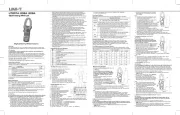
10 September 2025
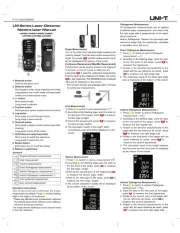
10 September 2025
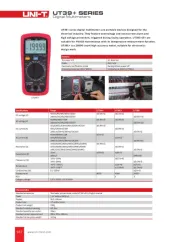
10 September 2025
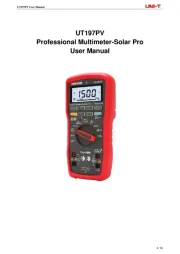
6 Augusti 2025

19 Juni 2025

18 Juni 2025

18 Juni 2025
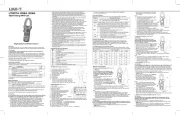
18 Juni 2025
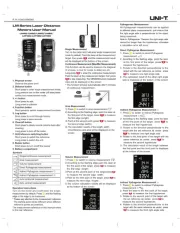
18 Juni 2025

16 Juni 2025
Multimeter Manualer
- Högert
- Cablexpert
- Hager
- Elma
- Megger
- Caltek
- Gembird
- GW Instek
- Wago
- Powerfix
- Sonel
- Voltcraft
- Multimetrix
- Beha-Amprobe
- Tacklife
Nyaste Multimeter Manualer
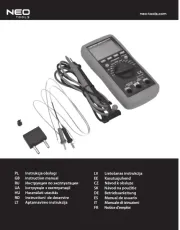
20 Oktober 2025
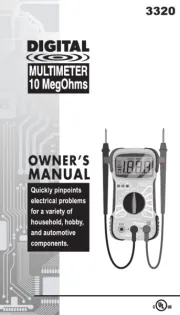
13 Oktober 2025
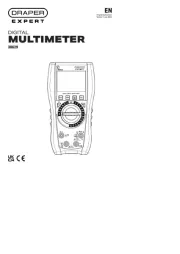
7 Oktober 2025
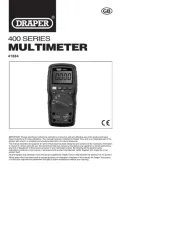
7 Oktober 2025
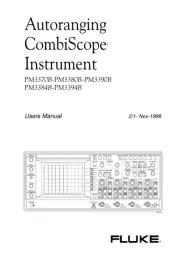
26 September 2025

26 September 2025
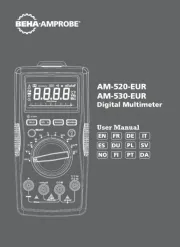
26 September 2025
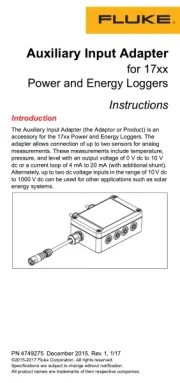
26 September 2025
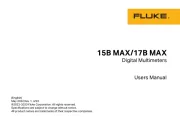
26 September 2025
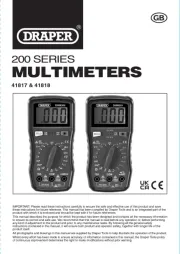
26 September 2025